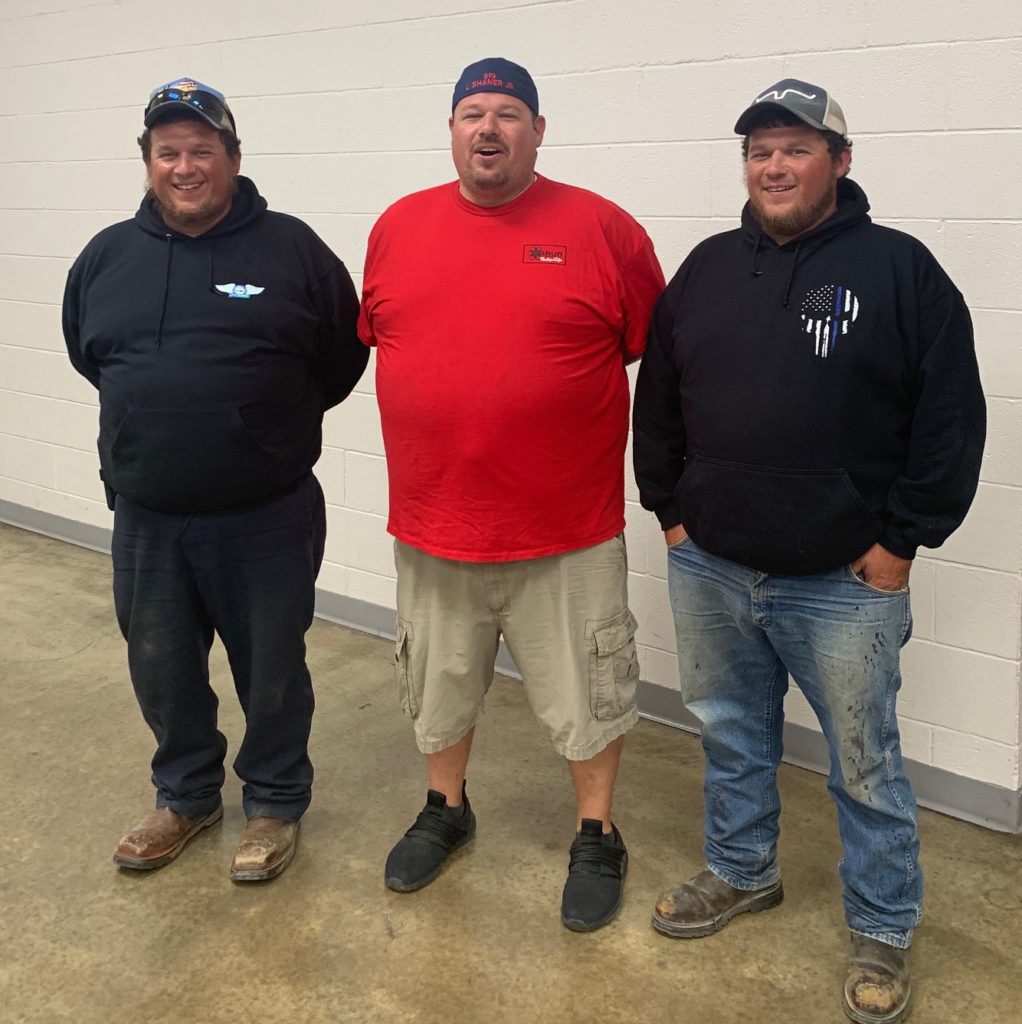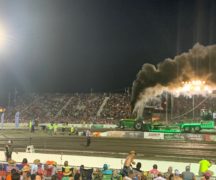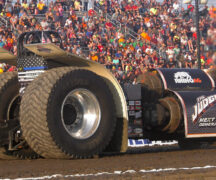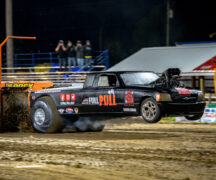By ANDREW BAILEY
BG Independent News Correspondent
More than 200 men and women, many of whom have full time jobs, volunteer year-round to put on the world’s largest tractor pull.
Why?
They love the sport. They love the fans and the pullers. They love the machinery powering the massive rigs. And they love the spectacle.
These 225 people are members of the Northwestern Ohio Tractor Pullers Association — more commonly known as Blue Shirts. They are governed by nine directors, who in turn oversee about the dozens of crews who handle various tasks, from merchandising to planning parking space for tractors to getting the trophies to their respective winners.
“We have crews for everything you could think of,” NWOTPA Secretary Dave Schultz said. “It takes a ton of collaboration and trust to do what we do.”
Most members have experience in fields that assist them in their duties. Many of them are farmers, mechanics, construction workers, or former pullers.
Each crew has a leader who reports their progress to the board of directors. But with the litany of tasks across Pulltown’s more than 6,000 square feet, “we have to work like clockwork.”
“But everyone knows what they’re doing. We have people with decades of knowledge doing this,” Schultz said. If they run into unexpected problems — which happens quite often — the directors are there to help.

In a typical drive across the grounds, President Mike Erford said he’ll make “anywhere from 10 to 20 stops.”
“Usually I’ll just stop and ask a crew how they’re doing, if they need anything. Sometimes I just want to stop and say ‘hi.’ But my job involves me going back and forth around these grounds every day, doing meetings, making sure it’s running as smooth as it can,” Erford said.
Too much rain over-moistening the dirt track, rigs parking an inch outside of their designated space offsetting a whole row, heavy machinery breaking down, and members calling in sick are just some of the problems the Blue Shirts can encounter daily.
But they wouldn’t be able to pull it off if they weren’t problem solvers, Schultz said.
“If we let one bump in the road put us off track, this would never happen. If we let a hundred bumps in the road stop us, it wouldn’t happen either,” Erford said.
Their work continues year-round, and planning for next year’s tractor pull begins about 18 months in advance, Schultz said.
The days of the pull itself are the most work intensive. The day begins for the directors around 4:30 a.m. to work with press covering the pull. The rest of the Blue Shirts are up and working soon after, and workdays don’t end until well after midnight.
Then, they go back their campsites to get a precious few hours of sleep before they start again the next day.
“For a lot of members, this is actually their vacation,” Schultz said, himself included. “They love the pull so much they enjoy the crazy workdays as much as anyone would enjoy a day at the beach.”

The legacy of the shirt
The club was formed in the spring of 1962 with 20 members as the Wood County Tractor Pullers. After rapid growth in membership, they became the NWOTPA in 1964, and donned their blue shirts soon after.
The story behind the color is a simple one: a member’s wife was looking for shirts for her husband and some other members to wear, and she liked some blue shirts she saw, Erford said.
Now, with over 50 years under their belt, the blue shirts they wear are more than just apparel. The blue shirts carry a legacy. Membership in the club means pride in the pull, and some will drive almost an hour to attend the weekly meetings and camp out for the week surrounding the event.
There are multiple Blue Shirts who have been there since the beginning, like Eldor Gerken and Roger Williams.
Gerken, who leads the track crew in preparing the dirt ahead of the pull, and maintaining it during the event, joined in 1970.
“And I just couldn’t stop coming back,” he said.
Williams came to his first in 1967, joining the Blue Shirts just a few years later.
“I saw all these people running around and working nonstop, I wanted to know what they were doing,” he said. “It turns out I found something that I’d love doing for the rest of my life.”
Members typically join through family and friends who are already involved. For many, the Blue Shirts are a family legacy too.
Larry Shaner Jr. and his twin brothers, Nolan and Tyler, are the third generation of the Shaners to become Blue Shirts, succeeding their late father and grandfather.
Larry has been an official member for 20 years, after assisting his father and grandfather in the catering crew when he was 8 years old.
It takes a crew to feed the other crews, and Larry said that showed him the importance of the Blue Shirts. His father and grandfather took pride in making sure the others were well-fed, and he joined the campground operations crew after graduating high school, directing traffic around the grounds, and making sure the campers get to bed safely.
Nolan and Tyler started helping when they were 10 years old, feeding the Blue Shirts too. After their graduation, they joined the gate security crew, checking bags for glass and other banned items.
“Our father and grandfather inspired us to do it,” Nolan said. “And we wanted to follow (Larry) in their footsteps.”
The crews
Now, the catering crew is led by Blanca Dayss, one of the almost 30 women who are Blue Shirts.
They used to only have sandwiches, but once Dayss came on board to join her husband Glenn, she started cooking up meals with burgers, cookies, veggies, and more.
“Some weeks I’ll make 400 pounds of brisket just to feed everyone. Then, it’ll be 400 pounds of something else,” she said. “Just making sure everyone has enough to eat is a task in itself.”
Catering is just one of about 30 crews.
“It’s like one giant jigsaw puzzle. Everything fits into its place, and the picture is the beauty of the tractor pull,” Schultz said.
The puzzle needs to make profit, and that couldn’t be done without merchandising.
Corey Maassel joined the Blue Shirts four years ago after attending tractor pulls his whole life. Two years later, he became the lead for the merchandising crew.
After the annual pull ends, they put the leftover product away and begin workshopping ideas for the next year. This involves surveying attendees, analyzing spreadsheets of sales, and ”trying to keep things fresh and interesting for each year.”
After last year’s pull being canceled due to COVID, they have a special limited edition collector’s coin available.
“It’s a very limited supply, there’s only 500 that we’ll have to sell, but it’ll be something neat to commemorate the people who came back to us after COVID,” he said.
And there will be something for the rowdier crowd too: the north side grandstand, also known as “the zoo.”
“We get a lot of noise from that side of track, and we wanted to make something for them, let them have a shirt to unify them,” Maassel said.
He said it will “be quite a sight” to see an entire grandstand with matching shirts erupt into cheers when a tractor makes an impressive pull.
The rowdy crowds, and many other fans, need rides around the grounds. They’d have to walk everywhere if not for the courtesy carts, a service to shuttle attendees to and fro.
“We’re constantly running from as soon as the gates, until sometimes as late as 3:00 a.m.,” Sue Kepling said.
Kepling, who was one of the first female Blue Shirts when she joined in 1996, has led the courtesy carts crew since 2014.
“We’re there for whoever needs us. Whether it’s someone who’s gotten injured, someone who needs a ride to the very back of the campgrounds, or someone who’s had a little too much to drink, we’ll pick them up and get them there safe and sound.”
If there is a crew that is heavily depended upon to make sure the tractors can actually pull, it’s the track crew, led by Gerken.
The bulk of their job begins a few days before the pull. The track needs enough moisture in the dirt for the tires to get traction, so Gerken and his crew drive up and down, spraying gallons of water into the dirt. Then, another vehicle drives the track, mixing up the dirt so the water gets spread out.
This process takes over three hours, Gerken said. But they have to strike a balance. Too much water and the tractors might get stuck in the mud. Too little and tractors will just spin their wheels. If it rains too much without enough time for the sunlight to dry out the excess water, they must do it manually.
During the event, a tractor pulls about every 90 seconds, Schultz said. This means the track crew has to quickly prepare the dirt again, so each tractor has similar pulling conditions for fairness.
Erford said if there are any members of the NWOTPA who work tirelessly, it’s the two ladies that run the office: Business Manager Rhonda Hogrefe and Administrative Assistant Pam Metzger.
“We’re like the wheels that make this thing run,” Hogrefe said. “We handle the day-to-day operations, and make sure everything is in place so everyone else can do their jobs.”
Hogrefe and Metzger are the only full-time employees, so when the volunteer Blue Shirts are at their full-time jobs or other commitments, they handle special projects that the Blue Shirts might not have time for.
Hogrefe deals with commercials, advertising, sponsorships, and anything that promote the pull.
“There is always something that keeps us in the flow, keeps us working. We’re working around the clock and around the year for each pull, and before you know it our tickets are sold out and the pull is just around the corner,” she said.
Metzger primarily handles ticket orders, a job that she has done with pride for 20 years.
Without anyone to sell tickets, the stands would be empty. Metzger can often remember customers just from their voices, and she considers fans who have been buying tickets for decades to be friends.
“When I hear a voice I know, it’s like getting to catch up with an old friend I haven’t seen for a year. I know what’s going on with them … sometimes it doesn’t even feel like a job since I enjoy it so much,” she said.
Metzger said they have 13,000 to 16,000 people in their database for sold tickets. “They give you their last names, and I could probably tell you the first names for a good portion of them. I get people that call for their tickets and I can practically hear them jumping over the phone, they’re so excited.”
“I think one of the things that makes me love this so much is hearing how much other people love it. Whether it’s someone ordering tickets over the phone, a Blue Shirt coming in to say ‘hi’ or ask for some help, or just a fan of the pull stopping to by to talk to us,” she said.

Surrounded by their passion
Most Blue Shirts used to attend the pull as fans. They would be there to watch their favorite divisions compete, chat with the pullers, or just enjoy the scale of the event.
Being fans of the event is what led many to join, and they were often introduced to the sport by family or friends.
Growing up in South Toledo, Schultz has been a gearhead his whole life.
“I loved cars, working on them, getting inside them and seeing what made them run,” he said.
In 1983, some friends of his told him to come to the tractor pull in Bowling Green.
“I was like, ‘sure, why not.’ I thought it could be fun and I went with them to see what it was,” Schultz said. “I’d heard that the tractors have these massive engines, and all sorts of crazy machinery inside them.”
“Little did I know I was going to find something that was going to be with me the rest of my life.”
Schultz attended the pull every year, and then he joined the Blue Shirts in 2003, after seeing them all over the grounds. “I had wondered who these guys were, and how they could get so close to everything. And then I decided I wanted to do that too.”
Other Blue Shirts are attracted to the spectacle of the event.
“You get to be a part of the biggest pull in the United States,” NWOTPA Director Tim Kohl said.
“Every time I camp out here for the week of the pull, and we start setting up, I’m like a kid waiting for Christmas,” he said. “And then it happens, and we all know how worth it all of this is.”
But the 225 Blue Shirts didn’t get that same feeling last year. The 2020 tractor pull was canceled on July 4, and for the first time in decades, the Blue Shirts didn’t have any work to do.
“It was one of the hardest decisions I’ve ever had to make,” Erford said. “But eventually, we knew we had to do it, we held out for as long as we could but eventually there was just no chance of it happening.”
“I felt like we had let so many people down, but after the decision settled and we began working on the 2021 pull after a while, we were all ready to make it the best it’s ever been.”
Erford’s love for the pull lies in the event itself. But since he has to work so much during it, he only has a few minutes to savor it.
“Every pull, I’ll go out there to track for a little bit. I’ve been at the pull for as long as I can remember now, but nothing beats that sight,” he said.
“I walk out there and look around and see hundreds of people who love the same things we do, who are here to support what we work so hard to make happen. The lights are on and they’re all cheering and it’s just one of the most beautiful things, it’s something you have to see with your own eyes. I think that’s what I’m most excited for this year, to see that sight again.”




